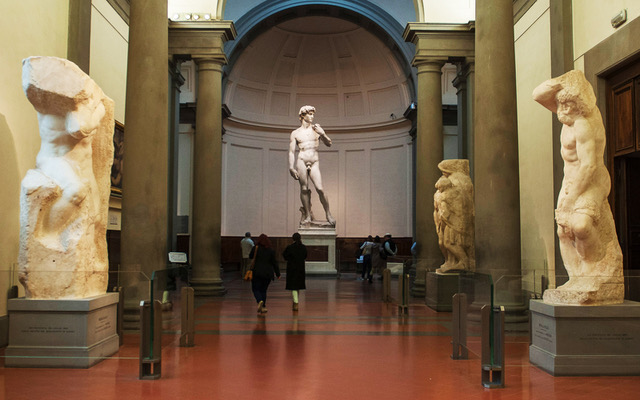Michelangelo’s magnificent sculpture of David was unveiled in the Piazza della Signoria in Florence. Sculpted from a massive block of marble, it took Michelangelo nearly three years to complete—at which point he was still only 29 years old. Intended as an image of the boy who defeated the giant Goliath, it has become a symbol of the tremendous potential of the human spirit and is arguably the world’s most famous statue.
Michelangelo Buonarroti was paid 400 ducats to complete the work that had been started in 1465—ten years before his birth—by a sculptor named Agostino di Duccio. Agostino selected his massive block of marble from the quarries of Carrara, located in the mountains 80 miles west of Florence. The marble was transported to Florence on barges dragged upstream by oxen along the River Arno and then placed in the Piazza del Duomo. Work commenced on the legs, torso, and feet, but a year later, Agostino ceased working on it after discovering a flaw in the stone. In 1476, another Florentine sculptor, Antonio Rossellino, was commissioned to finish the work, but his contract was rescinded—again, due to the flaw in the marble. For the next twenty-five years, this enormous and expensive block of marble, known as ‘Il Gigante’ (the Giant), lay unfinished in the centre of Florence, like a literal and figurative white elephant.
On August 16, 1501, twenty-six-year-old Michelangelo convinced the Operai, a 12-member committee, that he should be the one to finish the work, flaw or not, and bring it to perfection. He had recently gained fame for his beautiful Pietà, carved in Rome for the tomb of a French cardinal. The David was originally intended to stand dozens of feet overhead, on one of the buttresses of the cathedral. But when Michelangelo completed the work, which stands 17 feet (5 metres) high, a more conspicuous location was chosen, in the Piazza della Signoria, beside the Palazzo Vecchio, the town hall. It took four days to move the sculpture the 650 yards (600 meters) from the workshop to the piazza. Suspended in a wooden frame, it was rolled on fourteen greased logs by a team of more than 40 men.
In 1873, due to visible signs of weather damage and cracks in one of the legs, the statue was moved inside the Accademia Gallery for protection. Placed in a purpose-built wheeled wooden crate, it was transported from the piazza along a track similar to a railway. In 1910, a replica of David was placed in the Piazza della Signoria. Today, nearly a million and a half people visit the Accademia Gallery annually to see the awesome power of the David.

